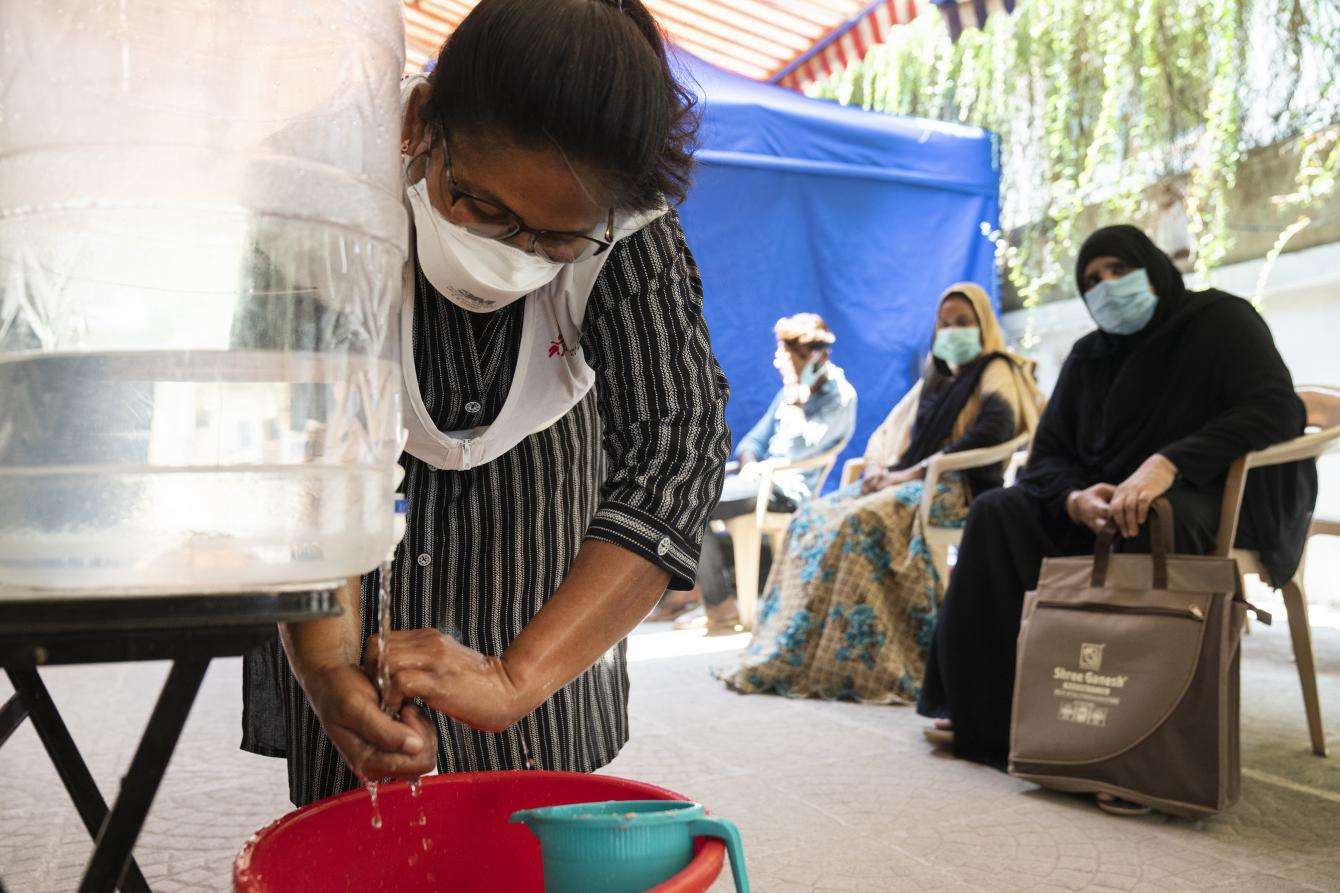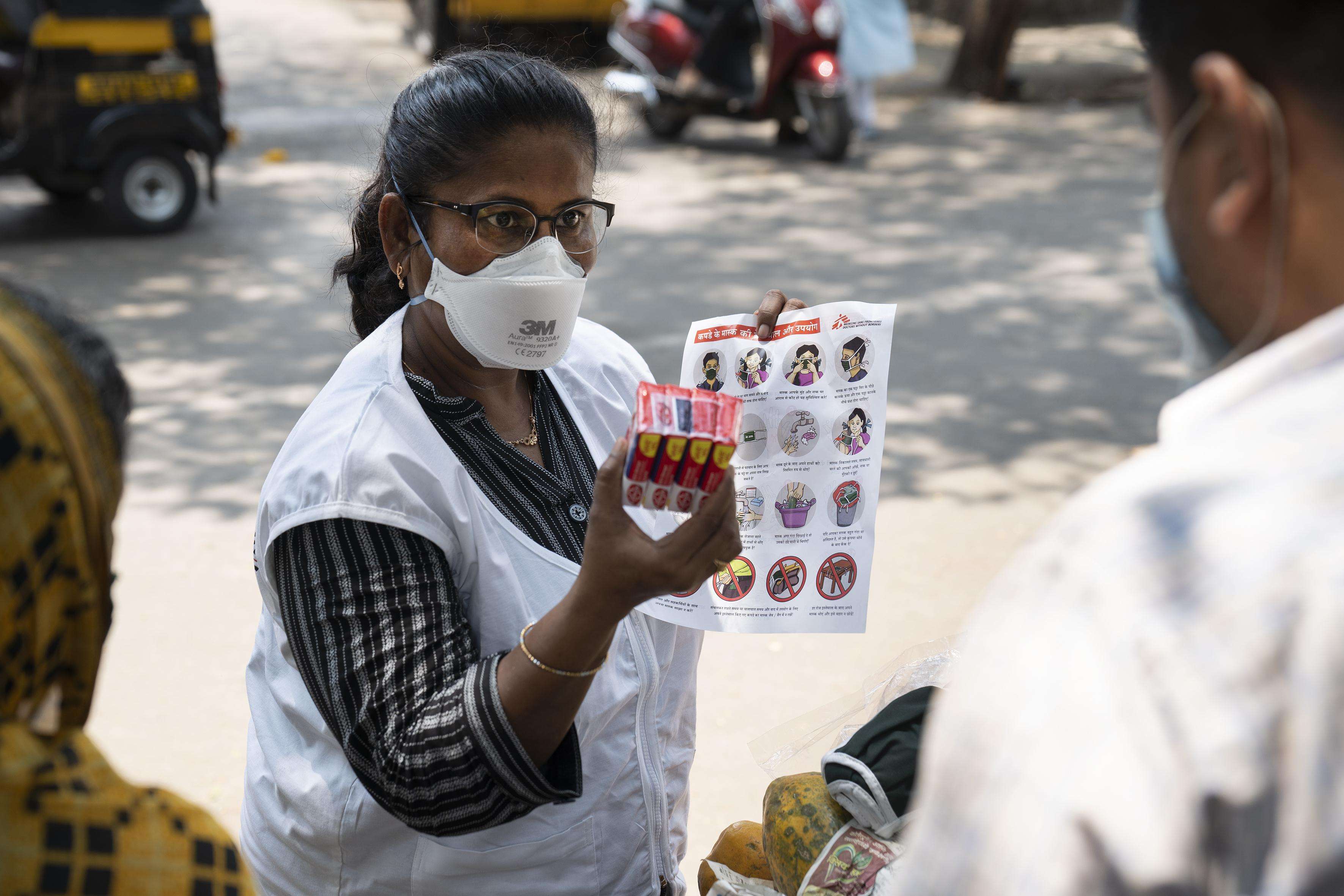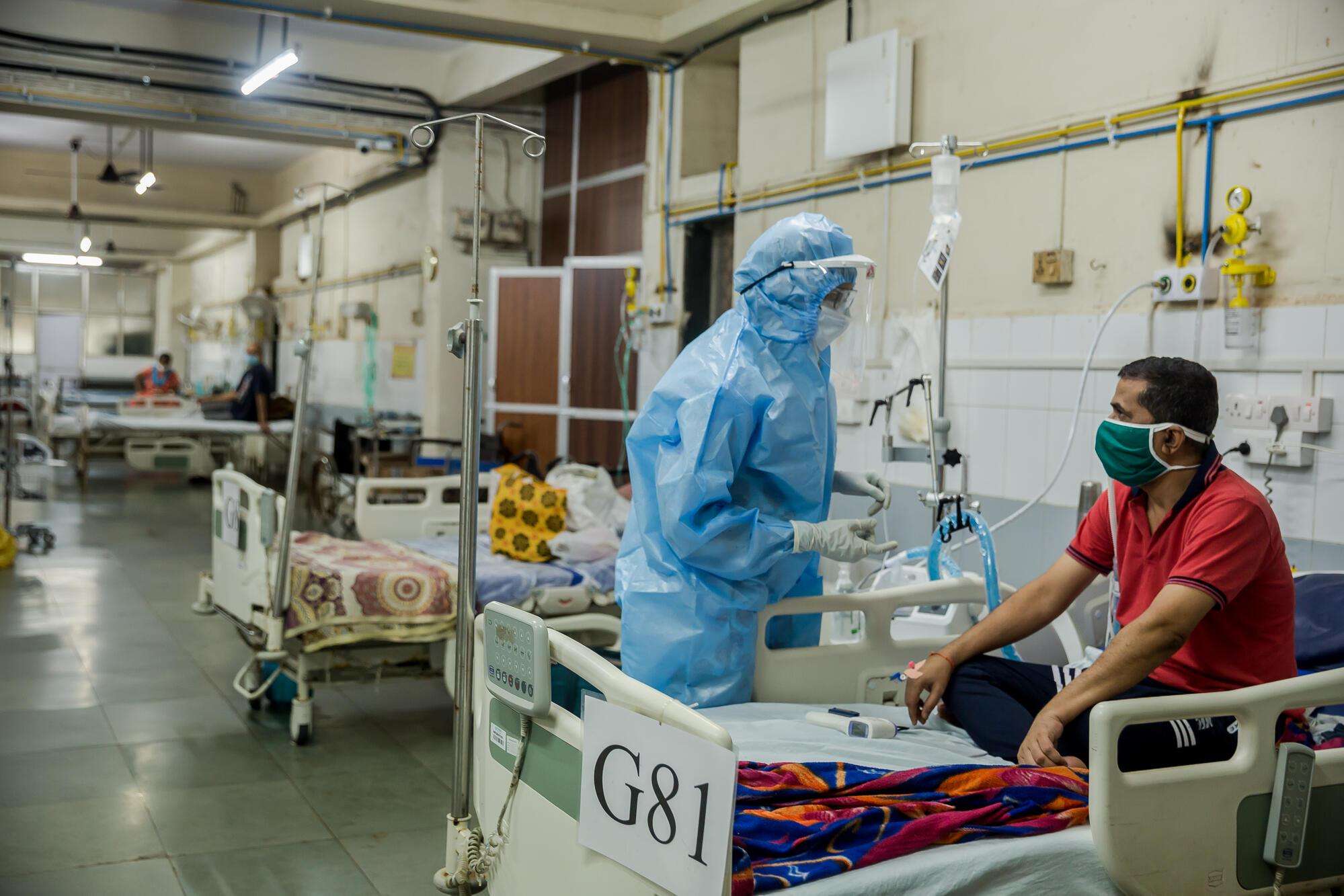A devastating second wave of COVID-19 is sweeping across India, fueling a massive spike in the number of cases. Of the more than 21 million cases reported in the country so far, more than 8.3 million have been recorded in the past 30 days, with a grim single-day record of 412,262 new cases set on May 6. Health care providers and facilities are overwhelmed, and essential medical supplies like oxygen concentrators and ventilators are dwindling.
Doctors Without Borders/Médecins Sans Frontières (MSF) is responding to the crisis in Mumbai, the capital of western India’s Maharashtra state. Our teams are treating COVID-19 patients in a massive 2,000 bed facility set up by the Indian government, in addition to ensuring that people living with illnesses like tuberculosis (TB) continue to receive care. Here, MSF team members describe what they’re seeing on the ground.

Mabel Morales, MSF Medical Coordinator
The situation in India, and in Mumbai, is very bad. It’s critical across the country. There are many, many cases and the last week of April has seen a real increase. The health workers are overwhelmed and exhausted. There is so much work to do.
The authorities here are well organized and are adapting to the situation as it evolves as best they can. But as the cases increase, it’s getting harder to find beds. They’re calling from hospital to hospital trying to refer patients, but they’re struggling.
The situation is terrible, but the commitment and the dedication of the staff is extraordinary. There is a very strong feeling of solidarity in the team. People are so committed to helping the patients. Some of them worked with us in our first COVID intervention here in India during the first wave. As soon as we called them, they immediately came and joined us. That was a real boost for us. There are so many more cases now that the staff we have aren’t enough. We still need to recruit more.
No one was ready for the second wave. It caught everybody by surprise. In a very short time, it’s turned into a major crisis. It’s so much worse this time and it was so sudden. MSF had concluded its support to the COVID center in Mumbai in mid-February, as we had hardly any cases. But we kept the community activities going and kept in contact with the people who had worked with us the first time.
We’re doing a lot of work at the community level and are focused on vulnerable people and people with chronic health conditions. People’s living conditions are very challenging. How do you talk about isolation or social distancing when you have a whole family of eight people living in one room with no ventilation? How do you talk about the need to wash hands regularly when so many people have no easy access to water? How do you institute preventative measures in a situation like that? A lot of the key messages about avoiding transmission just don’t work in these situations.
The needs here are so great and what MSF is doing is just a small part. But it’s important for us to be here. Staff from other hospitals are coming to us to take part in the trainings and we’re able to support them and share what we know. We all feel a strong sense of solidarity with our patients and with the staff. I feel that we’re in the right place and we’re all working together. It’s hard work, but I’m happy to be part of it.

Dilip Bhaskaran, Project Coordinator
We have been collaborating with the Municipal Corporation of Greater Mumbai (MCGM) to co-manage a dedicated 2,000-bed COVID care center in Bandra Kurla Complex (BKC). MCGM is doing a great job and we started this collaboration during the first wave, providing patient care. Now, during the second wave, our role is to improve the quality of care for mild and moderate cases and ensure patient dignity in the facility.
Even though we are a small part of a big operation, our job is very important. Increasing the quality of care these patients receive and managing them well with oxygen in the facility means fewer people will need to go on to ventilator care in intensive care units.
Working on quality of care has two aspects: medical and logistic. On the medical front, the biggest issue is supporting and training new and junior medical staff in the public sector. After the first wave of COVID-19 a lot of doctors moved on to new positions, so now we’re working with lots of new doctors that are just out of school and need training in patient care and bedside management. It’s the same with pharmacy management and nursing care—the newer staff need supervision. Human resources is the biggest challenge, particularly for nurses. We’re just not able to find enough nurses.
Outside of the hospital, we’re also expanding our work in the community. We’ve been working in Mumbai’s M-East ward for a long time, running drug-resistant tuberculosis (TB) projects. The city is divided into 24 administrative wards and this is the one where there are a lot of needs. It’s a densely populated area and social distancing is a real challenge. More than 800,000 people live there and more than 70 percent of them are in informal settlements. These are the most vulnerable communities, and they are our target population for awareness-raising and preventive activities.
Our health promotion team is sharing COVID-19 safety measures and we’re also about to resume our water and sanitation work cleaning public toilets. These community toilet blocks can be used by over 1,000 people daily and are in terrible condition, so they are sites where infection can easily spread.

Aparna Iyer, MSF Medical Referent
It’s important that we don’t let COVID-19 interrupt services for our TB patients in M-East ward, where we run our TB project. We’re still diagnosing a lot of new patients with TB who have been unable to seek help due to the movement restrictions of lockdown. In our independent clinic and the outpatient department run in collaboration with the National Tuberculosis Elimination Program we’ve adapted to the restrictions, and for the last three weeks we’ve only been physically present in the clinic on alternate days to see new patients and provide consultations to the severely ill.
On the other days the medical team works from home carrying out virtual medical consultations and providing psychosocial support to our patients by phone. If necessary, they can be prescribed medication on WhatsApp that can be collected from local pharmacies. The community health workers who used to do home visits for contact tracing and TB education are now following up and providing support over the phone to keep the community and our health workers safe.
Many of the patients we treat in M-East ward are migrants who came to Mumbai looking for work and settled down here. They are daily wage workers and last year, during the first wave, they were hit particularly hard. Many lost their jobs and were forced to return back home. For people with drug-resistant TB, this meant an interruption to their critical treatment as the drugs they required are often not available in smaller cities or more rural areas.
Our patient support team tried their best to ensure continued care for these patients by linking them to the respective TB treatment centers in their places of origin, but many couldn’t be reached. In order to avoid the same situation this year we’re proactively reaching out to our migrant population patients, asking them to contact us if they have to leave and let us know where they are going so we can send a supply of medications to their local health centers and get in touch with their local medical teams. We need to ensure a smooth transition and continuity of care for them as they travel home. We’re also offering telephone counseling to try and help with other problems they may face, including the loss of work or difficulties obtaining their daily ration support.
My biggest concerns are the knock-on effects of COVID on other aspects of health care. Right now, so many hospitals, health care centers, and human resources are being diverted to the COVID response that other vulnerable patients like those with TB, HIV, diabetes, or hypertension are having to travel further to find somewhere that can treat them. Currently it’s much harder for them to get the help they need.
I’m concerned about oxygen availability and isolation bed capacity, including critical care, for drug-resistant TB patients coinfected with COVID. What will happen if patients start falling sick when we need greater capacity for accommodating those with critical needs? If patients are waiting for surgery and they are being deprioritized because COVID has to be dealt with first, then patients waiting for surgery may develop a lot more complications.

Santosh Choure, Health Promotion Manager
Mumbai is still seeing more than 3,000 new cases of COVID every day. People are scared and many of them don’t want to get tested even though they have symptoms, as they’re afraid of being quarantined or hospitalized and separated from their families.
I manage a team of 10 health promoters and we’re expecting 10 to 12 more very soon. The team is tasked with raising awareness in the community. Community health workers travel through the narrow lanes of the informal settlements on tuk-tuks [auto rickshaws] delivering COVID prevention messages through loudspeakers and sharing information on COVID services available at ward level.
We conduct handwashing demonstration sessions and meetings in the community with residents, patients waiting in public and private health care centers, and private doctors and health workers. We also reinforce messaging about wearing masks, social distancing, and other ways COVID can be prevented. We’re also doing digital health promotion, reaching thousands of people on Facebook with videos and messaging, especially the younger generation who is active on social media.
Another important part of our work is helping protect particularly vulnerable people—drug-resistant TB and HIV patients, those with diabetes or hypertension, or the elderly. We aim to reach out to more than 5,000 families to provide them with hygiene kits including masks, soaps, hand sanitizers, and floor cleaner to help them protect themselves. We’re also staying in contact with them on a weekly basis by phone to provide regular health promotion information, advice, and counseling.
We’re all part of this community and are really motivated to help as much as we can. But we need more people and more actors doing health promotion to promote COVID-19 prevention and testing.





